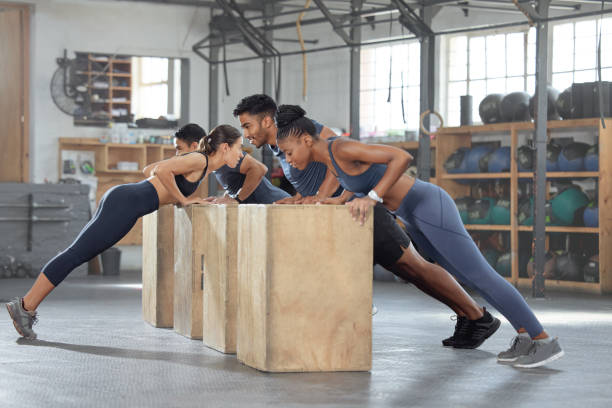In the pursuit of enhanced muscular strength and physical performance, one doesn’t always have to confine themselves to the confines of a traditional gym. While weightlifting has its merits, there are alternative methods that can yield significant gains. Plyometric training, characterized by explosive movements such as jumping, hopping, and skipping, offers a unique approach to strengthening muscles, tendons, and the nervous system. This article explores the benefits of plyometric exercises, considerations to keep in mind, injury prevention techniques, and how to incorporate plyometrics into your fitness routine.
Benefits of Plyometric Exercises
1. Improved Strength and Muscle Size
Numerous studies have consistently demonstrated that plyometric training can lead to significant improvements in strength and muscle size. The explosive nature of these exercises engages fast-twitch muscle fibers, which are crucial for generating force and power. This increased muscle activation can result in substantial gains in both strength and muscle mass.
2. Enhanced Muscle Speed and Coordination
Plyometric exercises require rapid and precise muscle contractions. As a result, they can greatly enhance muscle speed and coordination. This is especially valuable for athletes in sports that demand quick movements and reflexes, such as basketball or soccer.
3. Benefits for Older Adults
Contrary to popular belief, plyometric training is not limited to athletes or younger individuals. Research has revealed that older adults who engage in plyometric exercises, such as vertical jumps, exhibit superior jumping and stair-climbing abilities compared to those who solely focus on resistance training or walking. These exercises can help maintain functional fitness as we age.
4. Improved Bone Density
Engaging in activities like jumping rope, which is a form of plyometric training, has been shown to boost strength, flexibility, and bone density. It’s worth noting that this form of exercise isn’t just beneficial for muscle development but can also have a positive impact on your skeletal health. In fact, it has demonstrated benefits like increased bone density, particularly in women.
Considerations for Plyometric Training
While plyometric exercises offer a host of benefits, they also come with some considerations, particularly related to the risk of injury. In the past, it was recommended that individuals avoid plyometric training unless they could squat one and a half times their body weight and maintain a half-squat position on one leg for 30 seconds. However, these criteria primarily applied to advanced forms of plyometrics, such as drop jumps and bounding, which involve dropping off a platform onto one or both legs and subsequently springing back up.
Beginner-Friendly Plyometric Exercises
The good news is that there’s a wide range of plyometric exercises suitable for beginners. Low-intensity activities like skipping exert less impact on muscles and bones compared to higher-intensity plyometric exercises like jogging. Many individuals may already be incorporating plyometric exercises into their routines without realizing it.
The risk of injury in plyometric training increases with the force exerted upon landing. Hence, exercises like drop jumps and bounding should be avoided until adequate strength is developed. However, when tailored to an individual’s capabilities, plyometric training carries a low risk of injury.
How to Avoid Injury
For those interested in trying plyometric training, there are several fundamental movements to master in order to minimize the risk of injury:
1. Proper Landing Technique
Proper landing technique is crucial in plyometric exercises. When landing, it is important to land on the full foot while bending the ankles, knees, and hips to effectively absorb the force. This skill can be developed by practicing balance on one leg and gradually incorporating small hops, landing on both legs. Progression can be achieved by attempting to land on the opposite leg after hopping on one leg.
2. Focus on Jumping
Once landing technique is mastered, it is essential to focus on jumping. Start with an object of suitable height, such as a small step, and practice jumping up while utilizing the landing techniques to absorb the impact effectively. As confidence and competence increase, individuals can further intensify the exercises by performing squat jumps, where a regular squat is executed but followed by an explosive jump at the top of the movement.
3. Advanced Plyometric Exercises
For those seeking more advanced plyometric exercises, tuck jumps, which involve tucking the legs into the chest during the jump, can be incorporated. Additionally, try jumping forwards or sideways to challenge different muscle groups. Remember, the key objective of plyometric training is to develop elasticity, so aiming to be “springy” during each jump is essential.
4. Shock Jumps or Depth Jumps
The most demanding forms of plyometrics are known as shock jumps or depth jumps. These exercises involve dropping off a bench or box, usually exceeding 30 cm in height, and instantly jumping upon landing. Due to the high forces experienced during landing, shock jumps should only be performed after mastering all other techniques and developing confidence in executing them.
Incorporating Plyometric Exercises into Your Routine
To include plyometric exercises into your fitness routine, aim to do them 1-3 times a week. The best thing about these exercises is their versatility; you can perform them at home or in a gym like Fitness 19.
Here’s a plyometric workout you can try now: Plyometric Workout Video
Incorporating plyometrics into your routine can provide a dynamic and effective way to enhance strength and fitness. However, it’s important to start at an appropriate level of intensity, focus on proper technique, and gradually progress as your abilities improve. By following these guidelines, you can harness the power of plyometric training to boost your strength, speed, and overall physical performance. Remember that safety and injury prevention should always be a top priority as you embark on your plyometric journey.
